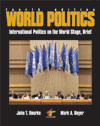This chapter has two purposes. The first is to establish a historical foundation on which to build our analysis of international relations. To this end the following pages give a brief historical narrative that emphasizes the themes and events you will encounter repeatedly in this book. The second goal of this chapter is to sketch the evolution of the current, rapidly changing world political system (Robertson, 1997). The concept of an international system represents the notion that the world is more than just a sum of its parts, such as countries, and that world politics is more than just the sum of the individual interactions among those parts. The idea of an international system is also based on the belief that there are general patterns of actions among the system's actors. These patterns can be explained in part by the distribution of power and several other factors that we will explore in chapter 3. It would be wise to keep your mind open to change. The current international system evolved relatively slowly for several centuries, then shifted rapidly during the twentieth century. Warp-speed technological innovation is the most important source of change. It has brought benefits such as nearly instantaneous global communications, rapid travel, less disease and longer lives, and enhanced material well-being. Breakneck technological change has also created or intensified many new problems, such as global warming, the expanding population, and nuclear weapons. Whether these changes are good or bad, there can be little doubt that, as one scholar has written, there is "turbulence in world politics" as "Spaceship Earth daily encounters squalls, downdrafts, and windshears as it careens into changing and uncharted realms of experience" in the twenty-first century (Rosenau, 1990:4, 7). |



 2002 McGraw-Hill Higher Education
2002 McGraw-Hill Higher Education